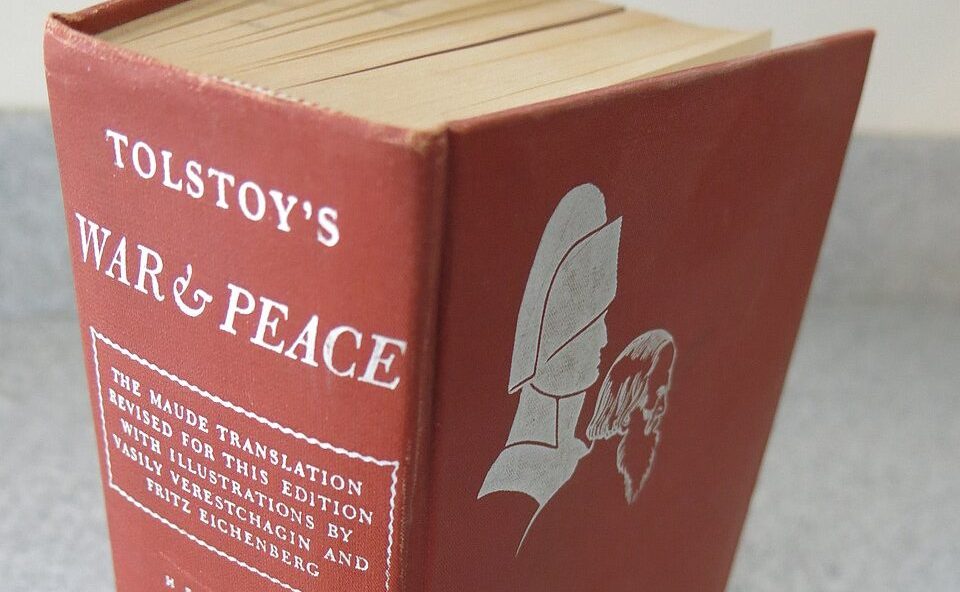War and Peace – is it worth reading?
More often than not, War and Peace is the work that comes to mind when one thinks of a long book. When editions often total over 1,400 pages, this is hardly surprising; it is a mammoth work, as difficult to physically hold as it is to endure. Ever since I made the perhaps ill-advised decision to ask for War and Peace for Christmas in 2019, it has sat on my shelf, gathering dust rather than my attention. However, with blissfully early coursework deadlines as a Literature student, I finally set myself the task of reading War and Peace across the final term of this year. Having come through to the other side, let us now look at what makes War and Peace a persistently captivating work.
Written by Leo Tolstoy and published in 1869, War and Peace spans across 15 years and examines the impact of the Napoleonic Wars across every echelon of Russian society. It has defied classification, with Tolstoy himself hesitating to deem War and Peace a novel. If anything, War and Peace is an embellished historical textbook; while most of his characters are fictitious, the events that shape them – and Tolstoy’s engagement with them – are true to history. Thus, to even read War and Peace requires homework; for me, at least some context of the Napoleonic Wars was essential, as Tolstoy thrusts readers into the bustle of nineteenth-century Russian society and expects them to acclimatise. There are also narrative roadblocks; there are at least a dozen primary characters, all of which are referred to by a variety of titles. My edition of the text came with a handy page outlining the characters and their relationships to one another, and, believe me, that page received its fair share of use during the opening chapters. However, what I’m trying to say is this: War and Peace is only initially a test of endurance. Once the inevitable challenges that a work of this scope produces are overcome – and they will be – Tolstoy’s prose can truly be appreciated.
For a narrative that unremittingly showcases the absolute worst in humanity, Tolstoy resorts ultimately to celebrating its very best
What is perhaps most astonishing about War and Peace is Tolstoy’s seemingly boundless range. Sprawling monologues concerning the horrors of war are counterpointed by detailed descriptions of the minutiae of Russian society, be it a card game or a winter hunt. Similarly, Tolstoy diversifies his cast of characters, from the sheepish yet lovable Pierre to the deeply flawed yet sympathetic Natasha. Through large, unique family structures, Tolstoy paints a meticulously complete and realistic portrait of Russian society. While such historical precision could become stale in its realism, Tolstoy infuses his characters with such emotional intensity and offsets any such possibility. Love is an easy tool to produce catharsis in the reader, but after such an enormous narrative that pushes its characters across such emotional and geographical distances, the eventual marriages of Pierre with Natasha and Nikolai with Marie are nothing short of triumphant. For a narrative that unremittingly showcases the absolute worst in humanity, Tolstoy resorts ultimately to celebrating its very best.
Amidst Tolstoy’s narrative are various philosophical discussions regarding the historical events that War and Peace recounts. Much like the precision of his narrative, Tolstoy philosophises in a methodical, evenly structured manner to guide tentative readers through more complex chapters. Tolstoy’s subject matter is also undeniably engaging, be it commentary on the nature of history or an examination of power. I do take some issue, however, with the structuring of Tolstoy’s narrative with his discussions; the text, for example, is concluded by a final philosophical epilogue that is an unequivocal strain to finish. However, perhaps my greatest complaint with Tolstoy’s more philosophical chapters is that they sometimes tend to repeat information that is exchanged in the dialogue of Tolstoy’s narrative – there is indeed a reason why War and Peace is as long as it is.
Tolstoy’s work is material proof that war – in all its forms – cannot prevail
So, amidst it all, what is Tolstoy trying to say in War and Peace? At its foundations, War and Peace is history; to some degree, Tolstoy seeks to educate in his vivid realisation of Russian society. In doing so, there is a duality not only in Tolstoy’s world, but also that of the reader; war and peace are both equally fragile states of existence, whether these are experienced psychologically, politically, and geographically. However, written within the context of the narrative – from an undefined future, Tolstoy’s work is material proof that war – in all its forms – cannot prevail. Indeed, by presenting death as merely another facet of life and ultimately concluding his characters’ journeys through love, Tolstoy’s energy for life is unbounded.
To try to consider War and Peace in so few words is an impossibility, yet I hope I managed to convince a few readers to pick up Tolstoy’s great tome. There is no doubt that War and Peace carries a daunting reputation, but social opinion elides the unparalleled quality of Tolstoy’s prose, depth, and detail. There are many treasures to be found amidst War and Peace’s half a million words, and it will stay with its readers forever.

Comments